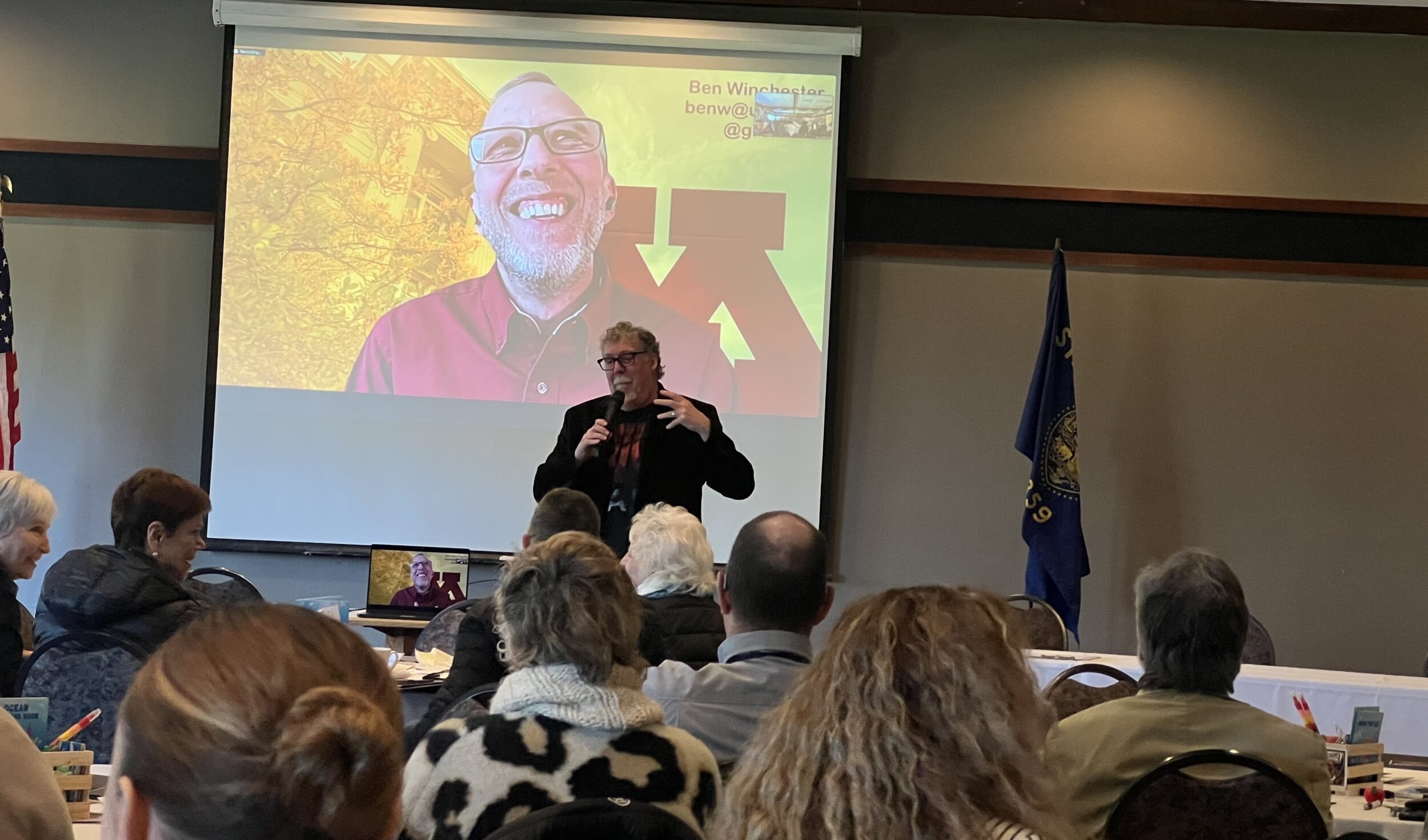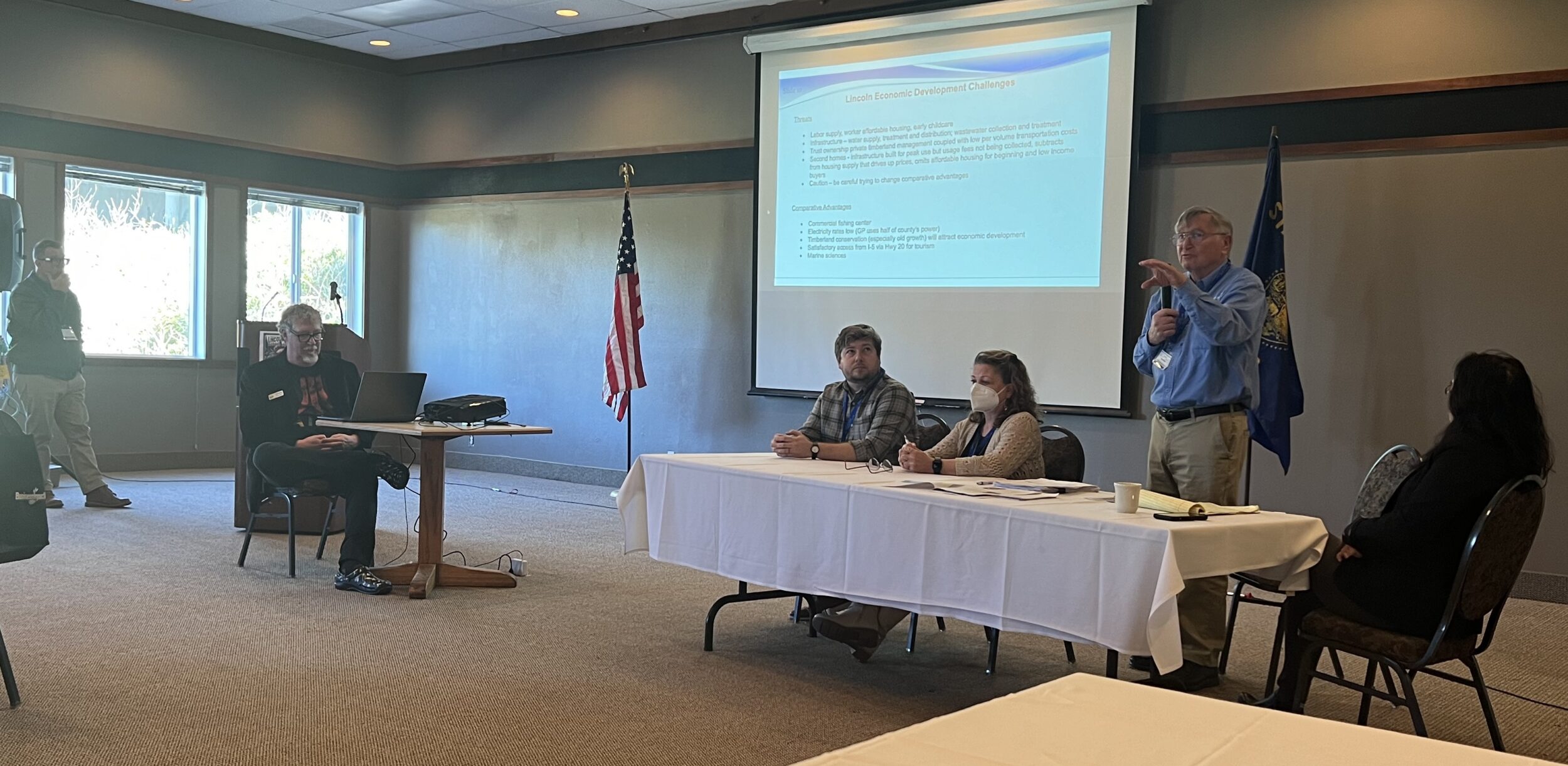
By QUINTON SMITH/YachatsNews
Ben Winchester may have been dialing in from Minnesota, but he had a clear message for 75 people attending the 2024 Lincoln County Economic Summit on Thursday – rural communities aren’t dying, they’re just changing.
They always have. They always will.
There is no brain drain, said Winchester, a rural sociologist for the University of Minnesota Extension. That’s just a media stereotype “not based in reality” because the largest group of people moving into rural areas are age 30-49.
A housing shortage? That’s been a rural issue for 15 years, not the last five.
And shrinking rural populations? Just not true, he said via Zoom to public officials, economic development staffers, nonprofit leaders and businesspeople meeting for the day at Otter Crest Resort at a conference sponsored by the Economic Development Alliance of Lincoln County.
The population of rural areas has increased 11 percent since 1970, he said, it’s just that urban areas grew faster by spreading out into once-rural areas and creating suburbs.
Winchester’s message was just that – don’t misuse anecdotes he calls “anecdata” that are based on a one statistic and often amplified or misused by the media. Rural communities have issues, but they’re because of long-term societal changes that have been occurring since towns were first established. And urban areas have issues too – it’s just that they’re often different and well-publicized.
“For every store that closes in a small town, three close in a large city,” he said. “But you never hear about that because people there have other choices.”
Winchester is a sociologist who focuses on rural data and is upbeat on what he sees. Collect and use data to help make decisions and choices, he said, which was the focus of the daylong gathering.
Other points Winchester made from his surveys and research included:
- Newcomers to rural areas are seeking a simpler pace of life, safety and security, and lower housing costs. “Nowhere in the Top 10 reasons for moving was because of a job.”
- Newcomers to rural areas weren’t just moving “back home,” as many think. Some 75 percent of new rural residents had never previously lived in the area;
- County boundaries that governments rely on today were created “in the time of horse and buggies” and do not reflect how people live today. People live more regionally, commuting in and out of rural communities to work, shop and seek services. Just 54 percent of Lincoln County’s workforce also lives in the county;
- People move all the time. “On average, Americans move 12 times in their lifetimes” including in and out of rural communities.
- The number of rural nonprofits and volunteers is increasing, not decreasing. But they are engaged in new or different endeavors, especially “interest-based” activities. “This is not the story of social life dying, but the story of social life diversifying.”
Like other economists who spoke later, Winchester said housing remains a critical issue in rural communities. But it’s not necessarily because of lack of housing, but the lack of movement.
“The churn of homes is extremely slow,” he said. “Older people are not moving out of family homes as they used to. They’re staying.”
Also, he said, many homes sold in rural communities sell without a real estate listing but instead person-to-person. “We tell people, ‘If you want to find a home in a rural area, go talk to seniors after church’.”
Half of the homes in Lincoln County are owned by people 65 and older, Winchester said. But that also means there could be a big surge in housing turnover as those people die or are forced to move closer to family or care.
“There’s change coming,” he said.

Other points from conference speakers included:
- Shaun Barrick, the new regional economist for the Oregon Employment Department: The number of jobs in Lincoln County “has completely recovered” from the Covid pandemic, but wages increases have not kept pace with inflation since 2020.
- Hans Radtke, an independent economist from Tenmile: While regions of Oregon that continue to over-rely on a resource-based economy “have not done very well” Lincoln County needs to recognize that it is relies more and more on retirement “transfer” income such as social security, medicare and also investment spending. While there are issues with labor supply, childcare and housing, Radtke said, Lincoln County’s advantages includes being the center of commercial fishing in the state, very low electrical rates, the great potential for using old growth timber for carbon sequestration, ready access to Interstate 5, and the benefits of the scientific community at the Hatfield Marine Science Center.
-
To hear more from Ben Winchester about rural changes, go here




On homes currently held by 65+ that will be becoming available in the future: We looked at a couple of these when we were seeking our current home. The places were in deplorable condition because the elderly folk living there previously did not have the funds to maintain them or simply never did. Or do-it-yourself renovations had been performed and even those were aging badly. So what was the real issue? The homes were priced as high as other similar properties and would have required an additional $100,000 or more to bring them up to a livable standard. It used to be that homes like this would be on the market for a low price because they were money pits.
Great information, thank you Economic Development Alliance for holding this conference and Yachats News for covering it.
One reason, and there are many, I suspect for the lack of turnover of homes is because Lincoln County doesn’t have the needed variety of housing. Older adults and singles, no longer need large single-family homes but due to a lack of options within cities to move into such as an added ADU, smaller homes, multifamily options, or even, in my imagination, mixed generational cooperative housing, they stay in their homes.
People would like to age in the place they have friends and social support if they can. The lack of housing choices, and robust public transportation, leaves them in homes that are too large but in a place they want to live. This leaves younger families without options to purchase these older existing homes, and new residents without any choices at all, creating a situation where far too many older people are forced to either move away from friends and family or remain in a home too difficult or expensive to maintain and workers unable to live in the county, moving elsewhere or far away from everything they want and need, which exacerbates traffic, air quality, and meeting environmental goals.
This conference brings such great information forward. I hope more conferences and discussions come in the future. Community health, transportation, economic development, resiliency, and caring for the environment we have all moved here to enjoy are interconnected and cannot be looked at in individual silos. Region-wide partnerships are the future.
In NY, and and Portland, there are organizations, that match seniors w/an “extra bedroom” or two with students, or people younger then the seniors, who are in need of housing. In PDX, the organization is: Oregon Home Share https://www.opb.org/article/2022/08/04/oregon-home-share-matches-seniors-with-spare-room-with-those-needing-housing/ Background checks are done on the people seeking housing, etc. No reason someone or someones can’t create such an organization in Lincoln county. The Second Home program seeks to place homeless highschool students with host famliies. That program was created by Oregon Ecumenical Ministries, and its first effort was in Beaverton. Despite the great need in Lincoln county, the program has been mostly non-functional since the pandemic because there are so few offer to be host families. That’s a different program then a house share, such as Oregon Home Share.
It would help many people age in place if they had assistance (financial, contractors willing to do the work) in installing changes, like ramps, safety bars, etc, in bathrooms, showers that can be walked into & large enough for a seat or a wheelchair. The VA will pay for some accommodations in the homes of veterans who meet certain criteria, Medicaid will sometimes provide grants, HUD, and it seems that OR has a state program (if it still exists) https://seniorsmobility.org/bathroom/bathroom-grants-elderly/
I see rural counties declining because of the lack of nearby medical care. Adventist recently closed its clinic in Lincoln City and a dialysis clinic in Tillamook closed not long ago. It seems as though Samaritan Health now has a monopoly of providing health care in the county and close to a monopoly in a tri-county area, how is that a good thing? An improvement? Very different then in the 1990’s into the mid-2000’s when there was a larger number of independent physician practices, plus a nurse practitioner w/her own practice in Lincoln City. I’d guess there are fewer MDs (Family Practitioners/GPs, internists and DOs) practicing in Lincoln county then there was 15-20 years ago. There was a small clinic in Yachats, that disappeared years ago.
It’s not just a problem on the central coast, it’s a problem in many rural areas.
Has the county or any of the towns tried to intiate any kind of home share program?
It’s great to have a news website that does well thought out/researched articles on many issues.